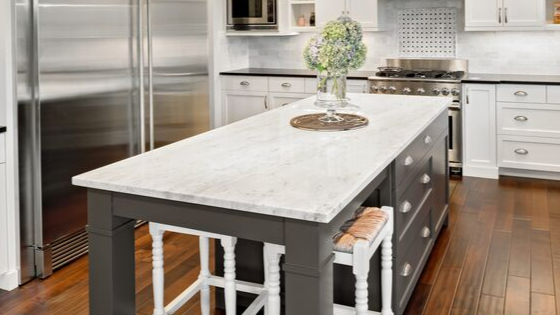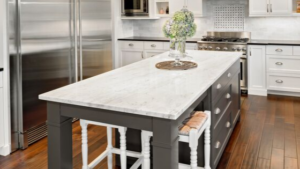Marble countertops have long symbolized elegance, craftsmanship, and timeless design. From ancient architecture to today’s modern kitchens, marble continues to captivate homeowners and designers alike with its natural beauty and one-of-a-kind patterns.
But before you bring this luxurious stone into your home, it’s important to understand what makes marble unique — and what it takes to keep it looking its best.
This blog is your go-to guide for everything you need to know, from the basics of what marble is to its pros and cons, finish options, and marble maintenance care tips.
Whether you’re considering marble for your kitchen, bathroom, or beyond, this blog will help you make an informed and confident decision about this classic countertop material.
Why choose marble countertops?
Aesthetic appeal
One of the most compelling reasons to choose marble is its aesthetic appeal. With its signature veining and subtle color variations, marble instantly elevates the look of any kitchen or bathroom. No two slabs are exactly alike, giving your space a truly one-of-a-kind appearance that synthetic materials simply can’t replicate.
Ideal for baking
Beyond its visual charm, marble’s naturally cool surface makes it ideal for baking and pastry preparation. Chefs and home bakers often gravitate toward marble for this reason alone. Its smooth, solid surface also feels substantial and high-end, adding an unmistakable sense of quality and craftsmanship to any room.
Lasting value
Marble also has lasting value. Its classic look never goes out of style, making it an excellent investment for long-term appeal and even increasing the resale value of your home.
Marble finishes: Polished vs honed
When selecting your countertops, the marble finish you choose will dramatically impact the surface’s look and functionality. The two most common options are polished and honed, each offering its own aesthetic and practical benefits.
A polished finish
A polished marble finish gives a glossy, reflective surface that enhances the stone’s natural color and veining. It’s perfect for those who love a sleek, sophisticated appearance.
However, polished marble tends to show scratches, etching, and water spots more easily, making it better suited for low-traffic areas or for homeowners who are diligent about maintenance.
A honed marble finish
On the other hand, a honed marble finish has a matte, velvety texture that offers a more subtle and contemporary look. Because it lacks the high-gloss surface, honed marble does better concealing scratches and etching, making it a practical choice for busy kitchens or high-use spaces.
However, honed surfaces may be slightly more prone to staining and usually benefit from more frequent sealing.
Ultimately, your choice between polished and honed will depend on your lifestyle, design goals, and how much day-to-day wear your countertops will experience. Both finishes offer beautiful results — it’s a matter of finding the one that suits your space best.
Pros of marble countertops
Marble countertops offer a range of benefits that go beyond their stunning appearance. Below are some of the top advantages that make marble a standout choice for kitchens, bathrooms, and beyond.
Natural coolness
Marble stays cooler than other countertop materials, which makes it perfect for baking and pastry prep. It’s a go-to surface for rolling dough or working with chocolate.
Adds resale value
Because marble is associated with upscale design, it can increase your home’s appeal and market value. Its classic look is unlikely to go out of style, making it a long-term investment.
Cons of marble countertops
While marble countertops are undeniably beautiful, they do come with a few considerations that are important to keep in mind. Understanding these potential drawbacks can help you decide if marble fits your lifestyle and how much maintenance you’re comfortable with.
Porous and prone to stains
Marble is naturally porous, which means it can absorb liquids if not properly sealed. Spills from wine, citrus, or oils can cause staining, especially on lighter varieties.
Easily etched by acids
Acidic substances like lemon juice, vinegar, or tomato sauce can etch the surface, leaving dull spots or marks. This can happen even if the countertop is sealed.
Softer than other stones
Compared to granite or quartz, marble is more susceptible to scratches, chips, and cracks, especially in high-traffic or high-use areas like kitchens.
Requires regular maintenance
It needs periodic sealing and gentle, pH-neutral cleaners for daily care to keep marble looking its best.
Marble countertops are an excellent choice for homeowners who are drawn to their timeless beauty and are willing to invest a little extra care to maintain their appearance. With the right upkeep and usage habits, marble can be a durable and elegant addition to your home for years to come.
Marble maintenance and care tips
Marble countertops are a beautiful investment; with the proper care, they can maintain their elegance for many years. While it is more delicate than some other materials, a few simple maintenance habits can go a long way in preserving its natural beauty.
1. Seal regularly
Marble is porous, so it can absorb liquids and become stained if left unprotected. Applying a quality sealant helps create a barrier against moisture and stains.
Depending on the type of marble and how often you use your countertops, sealing should typically be done every 6 to 12 months. You can test your seal by sprinkling water on the surface. If it beads up, you’re protected; if it soaks in, it’s time to reseal.
2. Clean with gentle, pH-neutral products
Avoid harsh chemicals and acidic cleaners, which can etch the marble’s surface. Instead, use a soft cloth or sponge and a pH-neutral stone cleaner or mild dish soap diluted with water. Wipe down your counters daily or after heavy use to keep them looking pristine.
3. Wipe up spills immediately
Acidic substances like lemon juice, vinegar, tomato sauce, or wine can cause etching — dull, discolored spots on the surface. Always clean up spills right away using a soft cloth and water to minimize potential damage.
4. Use cutting boards and trivets
Protect your marble from scratches and heat damage by using cutting boards when preparing food and trivets or hot pads under hot pots and pans. While marble is heat resistant, sudden temperature changes can cause thermal shock or leave marks over time.
5. Avoid abrasive tools
Never use steel wool, scouring pads, or rough sponges on marble. These can scratch or dull the finish. Stick to microfiber cloths or soft sponges for everyday cleaning.
6. Address stains and etches promptly
Create a poultice using baking soda and water or a commercial marble poultice product for stubborn stains. Apply it to the stain, cover it with plastic wrap, and let it sit for 24–48 hours before gently wiping it away. For etching, a marble polishing powder or professional refinishing may be required.
By incorporating these simple care habits into your routine, you can keep your marble countertops looking as stunning as the day they were installed. Regular marble maintenance protects your investment and enhances the natural elegance that makes it such a timeless choice.
Get your marble countertops from Intermountain Stone & Marble
Are you inspired to bring the timeless elegance of marble into your home?
At Intermountain Stone & Marble, we offer a stunning selection of premium marble countertops in a variety of colors, patterns, and finishes to suit any style. Our expert team is here to guide you through the selection process, answer your questions, and ensure your marble is installed with precision and care.
Whether you’re designing a new kitchen or upgrading a bathroom, we’re committed to helping you create a space that’s as functional as it is beautiful.
Visit our showroom or contact Intermountain Stone & Marble today to find the perfect marble countertop for your home. Let’s bring your vision to life — one stone at a time.


